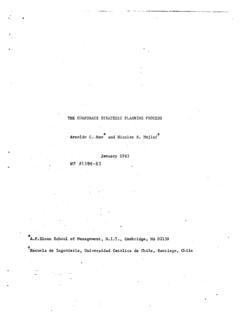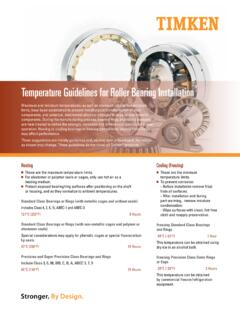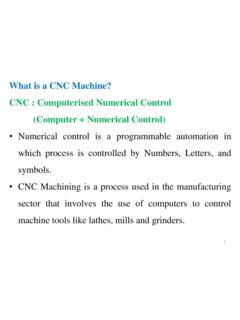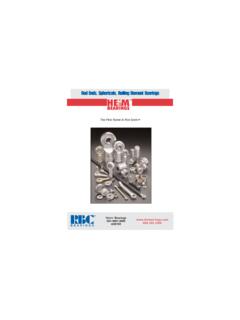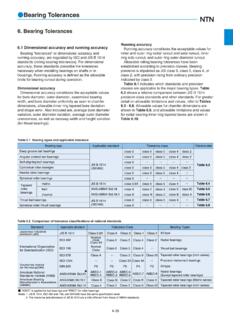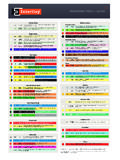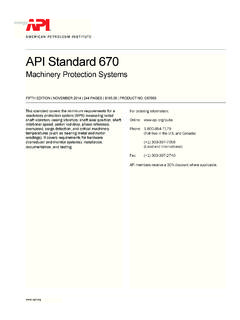Transcription of Topic 4 Linkages - DSpace@MIT Home
1 2000 Alexander Slocum4-1 Topic 4 LinkagesTopics History Definitions Links Joints Instantaneous Center of Rotation 3-Bar Linkages 4-Bar Linkages 5-Bar Linkages 6-Bar Linkages Extending Linkages Compliant Mechanisms Manufacturing & Robust Design Mechanism Mania! 2000 Alexander Slocum4-2 History The weaving of cloth gave rise to the need for more complex machines to convert rotary motion from waterwheels to complex motions The invention of the steam engine created a massive need for newmechanisms and machines Long linear motion travel was required to harness steam power, and machine tools ( , planar mills) did not exist James Watt(1736-1819) applied thermodynamics (though he did not know it) and rotary joints and long links to create efficient straight line motion Watt also created the flyball governor, the first servomechanism, which made steam engines safe and far more useful Leonard Euler(1707-1783) was one of the first mathematicians to study the mathematics of linkage design (synthesis) Most Linkages are planar, their motion is confined to a plane The generic study of linkage motions, planarand spatial, is called screw theory Sir Robert Stawell Ball (1840-1913)
2 Is considered the father of screw theory There is a HUGE variety of Linkages that can accomplish a HUGE variety of tasks It takes an entire course just to begin to appreciate the finer points of linkage design 2000 Alexander Slocum4-3 The First Mechanism: TheLever A lever can be used with a fulcrum (pivot) to allow a small force moving over a large distance to create a large force moving over a short When one considers the means to input power, a lever technicallybecomes a 4-bar linkage The forces are applied through pivots, and thus they may not be perpendicular to the lever Torques about the fulcrum are thus the best way to determine equilibrium, and torques are best calculated with vector cross product Many machines have used levers as flippers to assist othermachines onto their +inFRFcdbajiR = ai + bj F = ci + dJ = ad - bcThe Nanogateis a MEMS diaphragm-type lever for filtering nanoparticles 2000 Alexander Slocum4-4 Definitions Linkage:A system of linksconnected at jointswith rotary or linear bearings Joint (kinematic pairs):Connection between two or more links at their nodes, which allows motion to occur between the links Link.
3 A rigid body that possess at least 2 nodes, which are the attachment points to other links Degrees of Freedom (DOF): The number of input motions that must be provided in order to provide the desired output, OR The number of independent coordinates required to define the position & orientation of an object For a planarmechanism, the degree of freedom (mobility) is given by Gruebler s Equation: n= Total number of links (including a fixed or single ground link) f1= Total number of joints (some joints count as f = , 1, 2, or 3) Example: Slider-crank n= 4, f1= 4, F= 1 Example: 4-Bar linkage n= 4, f1= 4, F = 1 The simplest linkage with at least one degree of freedom (motion) is thus a 4-bar linkage! A 3-bar linkage will be rigid, stable, not moving unless you bend it, break it, or pick it up and throw it!()312 Fnf= crankslidercouplerCrank or rocker (the link to which the actuator is attachedfollower14 links (including ground), 4 joints4 links, 4 joints 2000 Alexander Slocum4-5 Links Binary Link: Two nodes: Ternary Link: Three nodes: Quaternary Link: Four nodes: Pentanary Link: Five nodes!)
4 (Can you find it?!)!?Can you identify all the links? 2000 Alexander Slocum4-6 Joints: Single Degree-of-Freedom Lower pairs (first order joints) orfull-joints(counts as f = 1 in Gruebler s Equation) have one degree of freedom (only one motion can occur): Revolute (R) Also called a pin joint or a pivot, take care to ensure that theaxle member is firmly anchored in one link, and bearing clearance is present inthe other link Washers make great thrust bearings Snap rings keep it all together A rolling contactjoint also counts as a one-degree-of-freedom revolute jointPrismatic (P) Also called a slider or sliding joint, beware Saint-Venant! Helical (H) Also called a screw, beware of thread strength, friction and efficiencytdD L 2000 Alexander Slocum4-7 Joints: Multiple Degree-of-Freedom Lower Pairjoints with multiple degrees of freedom: Cylindrical (C) 2 DOF A multiple-joint(f= 2) Spherical (S) 3 DOF A multiple-joint not used in planar mechanisms (f= 3) Planar (F) 3 DOF A multiple-joint(f= 3) 2000 Alexander Slocum4-8 Joints: Higher PairMultiple Degree-of-Freedom Higher Pairjoints with multiple degrees of freedom.
5 Link against a plane A force is required to keep the joint closed (force closed) A half-joint (f= in Gruebler s equation) The link may also be pressed against a rotating cam to create oscillating motion Pin-in-slot Geometry keeps the joint closed (form closed) A multiple-joint(f= 2 in Gruebler s equation) Second order pin joint, 3 links joined, 2-DOF A multiple-joint(f= 2 in Gruebler s equation)cdabjDAB ekhmRgfiH 1 2 1 2 3 4 2 1 3 ELpistonLboomFxFyMYXxF, yFcdabLpistoneRfDAB LboomFxFyMYXxF, yF 2000 Alexander Slocum4-93-Bar Linkages (?!): Accommodating bearing Misalignment A 3-Bar linkage (is this really a 3-bar linkage?!) system can minimize the need for precision alignment of bearing ways Accommodates change in way parallelism if machine foundation changes US Patent (4,637,738) now available for royalty-free public use Round shafts are mounted to the structure with reasonable parallelism One bearing carriage rides on the first shaft, and it is bolted to the bridge structure risers One bearing carriage rides on the second shaft, and it is connected to the bridge structure risers by a spherical bearing or a flexure Alignment errors (pitch and yaw) between the round shafts are accommodated by the spherical or flexural bearing Alignment errors ( ) between the shafts are accommodated by roll ( ) of the bearing carriage Vertical error motion ( ) of the hemisphere is a second order effect Example: = , H = 4 , = degrees, and = Abbe s Principle is used to the advantage of the designer!
6 ()()2arcsin1cos2 HHH = = 2000 Alexander Slocum4-10 4-Bar Linkages are commonly used for moving platforms, clamping, and for buckets They are perhaps the most common linkage They are relatively easy to create One cannot always get the motion and force one wants In that case, a 5-Bar linkage may be the next best thingabXY , FXYd FRx, yx+dx, y+dyds = (dx2 + dy2)1/2cdbaABCDC oupler point: move it to get thecoupler curve to be the desired shape4-Bar Linkages 2000 Alexander Slocum4-114-Bar Linkages : Booms Linkages for cranes and booms are 4-bar Linkages that replace one of the pivot joints with a slider The boomis the followereven though it is used as the output link The piston rodis the coupler The piston cylinderis the rocker , and the connection between the rocker and the coupler is a slider joint Link configurations can be determined using parametric sketches, sketch models, or spreadsheets Their simple nature makes them particularly well-suited for development by a spreadsheetcdabLpistoneRfDAB LboomFxFyMYXxF, yF 2000 Alexander Slocum4-12 4-Bar linkage motion can be developed usingkinematic synthesis: 3 Point Circle Construction Precision Point Method 3 Precision Point Example Loader Example ExperimentationInstant Center and pivot point become coincident and linkage becomes unstableApply reversal to the geometry and unstable becomes stable!
7 4-Bar Linkages : Kinematic Synthesis 2000 Alexander Slocum4-13 Kinematic Synthesis: 3 Precision Point Example3rdtry, crossing links1sttry, joints overlap, badAdd the links, with a kink in the follower to clear the rocker ground pivot2ndtry, better, but links cross4thtry, good! 2000 Alexander Slocum4-14 Kinematic Synthesis: Analysis Code or a spreadsheet can be written to analyze the a general 4-bar linkage, but types of motion can be anticipated using the Grashofcriteria: The sum of the shortest (S) and longest (L) links of a planar four-bar linkage cannot be greater than the sum of the remaining two links (P, Q) if there is to be continuous relative motion between two links If L + S < P + Q, four Grashofmechanisms exist: crank-rocker, double-crank, rocker-crank, double-rocker If L + S = P + Q, the same four mechanisms exist, but, change-point condition occurs where the centerlines of all links become colinearand the mechanism can toggle If L + S > P + Q, non-Grashoftriple-rocker mechanisms exist, depending on which is the ground link, but continuous rotation is not possible Geometric inversionsoccur when different pivots are made the ground pivots (this issimply an application of reciprocity) 7 6 5 , bcdd'b'baABCD icRicVLtrsu 8 9x, yFxFyXY 4 2 3 DriverSLL+S<P+Q crank-rockerQPSD riverL+S<P+Qdouble-crankPQLD riverSLL+S<P+Q rocker-crankQPDriverSLQPL+S<P+Qrocker-ro cker 2000 Alexander Slocum4-15 From the same analysis, the motions of the coupler point can be plotted.
8 -60-50-40-30-20-10010203040-80-60-40-200 204060X positionY position-100-80-60-40-200204060-100-80-6 0-40-200204060X positionY positionrr30s10a100b25cc100d25rr50s0a100 b50cc100d25ccdbaABCDC oupler pointrrsKinematic Synthesis: Coupler Curves 2000 Alexander Slocum4-16 Instant Centers The instant center of velocity (rotation) for two bodies in plane motion is a point, common to the two bodies, which has the same instantaneous velocity in each body This point may be a virtual point physically located off of the two bodies The instant center can be used to determine relative velocities between various links Knowing the relative velocity between links, and the torque input to one link, allows you to use conservation of energy to determine the output torque Can Linkages be designed with immense mechanical advantages? rolling wheel ground pivot & Instant CenterV= D/2 RRR R icInstant Centerbcd b d = ?inputoutputinputoutputinputinputoutputo utput = = 2000 Alexander Slocum4-17 Instant Centers: 4-Bar Linkages One can visualize the instant centerfor a point on a moving body as the center of the circular arc that coincides with the point s motion path at an instant in time For a 4-bar linkage, draw lines through the crank and follower pivots, and the point at which the lines intersect is called the instant center The velocity of any point on the coupler at any point is perpendicular to an imaginary line from the instant center to the point of interest The instant center is used to determine the linear and angular velocity and acceleration of the coupler s center of mass or the coupler point If the instant center is coincident with a joint on the coupler,the linkage can become unstable and can lock up, or the crank must reverse its direction A sketch model is a great physical way to check your linkage design!
9 This linkage s instant Center is always behind the pivots 7 6 5 cdd'b'baABCD icRicVLtrsu 8 9x, yFxFyXY 4 2 3 d b 2000 Alexander Slocum4-18 Instant Centers: Example Show the magnitude and direction of the Coupler Point for this 4-bar linkage: Draw lines through the crank and follower pivots, and the point at which the lines intersect is called the instant center The velocity of the Coupler Point is perpendicular to an imaginary line from the instant center to the point of interestccbABCDrrs c = 1 rad/secV = cm/sec ic = cmccbABCDC oupler PointrrsInstant CenterLicCdLicCPCrank angular velocity cVInstant Centerangular velocity ic 2000 Alexander Slocum4-19 Compare a simple 4-bar linkage for pliers or small bolt cutters to a 5-bar linkage (5 bars, 5 joints, 2 DOF) for bolt cutters The FRs of the pliers are for wide range of motion and modest clamping force The FRs of the bolt cutters are for modest motion with extreme force A 5-bar linkage can also act like a toggle mechanismCutting blade linksConnection linkmomentaryhalf-jointWhat effect doesthe screw haveon the pivot?
10 5-Bar Linkages 2000 Alexander Slocum4-205-Bar Linkages : Analysis To determine the force on the jaws caused by a force on the handles, equate the work done:dbaABFhxh, yhh 3 1 xj, yjFjCgXY 2 3 efmcij k 4 1 2 3cdebaABDFhxh, yhh 2 1k xj, yjFj 5 4 Cgj 3 4XY 2000 Alexander Slocum4-211E+001E+011E+021E+031E+041E+05 1E+061E+071E+081E+091E+101E+111E+121E+13 1E+1412345678910 Number of dimension incrementsNumber of calculation steps Simple Linkages often cannot meet FRs for large motion or extreme force A linear actuator cannot be effectively (huge stroke or huge forces are required) attached to a point on a 4-bar linkage to allow the output link to move through 180 degree motion , excavator bucket, concrete pump a 6-barlinkage112345611234561 Watt IWatt II1123456 Stephenson I1123456 Stephenson II11234561 Stephenson III12 parameters6 parameters35 crank input angular increments112346-Bar Linkages 2000 Alexander Slocum4-22 Many extending systems have the following FRs Compact for transport Rapid set-up Long reach capability during usecdabjDAB ekhmRgfiH 1 2 1 2 3 4 2 1 3 ELpistonLboomFxFyMYXxF, spacing/section lengthFront bearing force/Applied tip forceLLbearingFMFBrFBfExtending Linkages 2000 Alexander Slocum4-23 Extending Linkages : Scissor Linkages Scissor Linkages (Lazy Tongs) are a great way to get a LARGE range of motion in a smallpackage How does one develop a system as simple in principle, but as complex in detail as the Lazy Tongs?




